
Willem Boy
Encyclopedia

Flanders
Flanders is the community of the Flemings but also one of the institutions in Belgium, and a geographical region located in parts of present-day Belgium, France and the Netherlands. "Flanders" can also refer to the northern part of Belgium that contains Brussels, Bruges, Ghent and Antwerp...
painter
Painting
Painting is the practice of applying paint, pigment, color or other medium to a surface . The application of the medium is commonly applied to the base with a brush but other objects can be used. In art, the term painting describes both the act and the result of the action. However, painting is...
, sculptor, and architect
Architect
An architect is a person trained in the planning, design and oversight of the construction of buildings. To practice architecture means to offer or render services in connection with the design and construction of a building, or group of buildings and the space within the site surrounding the...
active in Sweden
Sweden
Sweden , officially the Kingdom of Sweden , is a Nordic country on the Scandinavian Peninsula in Northern Europe. Sweden borders with Norway and Finland and is connected to Denmark by a bridge-tunnel across the Öresund....
from around 1558 until his death.
Few of Boy's works have survived, and he is mostly remembered for the sarcophagus of King Gustav I
Gustav I of Sweden
Gustav I of Sweden, born Gustav Eriksson of the Vasa noble family and later known simply as Gustav Vasa , was King of Sweden from 1523 until his death....
in the Uppsala Cathedral
Uppsala Cathedral
Uppsala Cathedral is a cathedral located centrally in the city of Uppsala, Sweden. It dates back to the late 13th century and at a height of 118.7 m is the tallest church building in Scandinavia. Originally built under Roman Catholicism and used for coronations of the Swedish monarch, since the...
.
He is believed to have originated from Mechelen
Mechelen
Mechelen Footnote: Mechelen became known in English as 'Mechlin' from which the adjective 'Mechlinian' is derived...
and to have arrived in Sweden no later than 1558 during the late reign of Gustav Vasa to work as a painter of portraits. Within a few years he became one of the country's leading artists whose talents proved useful in a wide range of fields; he, for example, led the construction of the fortification at Vaxholm
Vaxholm
Vaxholm is a locality and the seat of Vaxholm Municipality, Stockholm County, Sweden. It is located in the Stockholm archipelago. The name Vaxholm comes from Vaxholm Castle, which was constructed in 1549 on an islet with this name on the inlet to Stockholm, for defense purposes, by King Gustav...
in 1589. Even though few of his works have survived, his influence on Swedish culture was considerable.
Sarcophagi
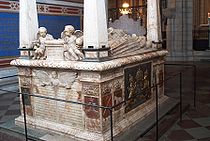
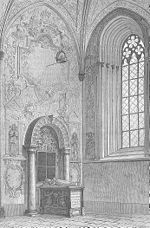
Flanders
Flanders is the community of the Flemings but also one of the institutions in Belgium, and a geographical region located in parts of present-day Belgium, France and the Netherlands. "Flanders" can also refer to the northern part of Belgium that contains Brussels, Bruges, Ghent and Antwerp...
to spend six years working on the sarcophagus
Sarcophagus
A sarcophagus is a funeral receptacle for a corpse, most commonly carved or cut from stone. The word "sarcophagus" comes from the Greek σαρξ sarx meaning "flesh", and φαγειν phagein meaning "to eat", hence sarkophagus means "flesh-eating"; from the phrase lithos sarkophagos...
of Gustav Vasa and his two first consorts Catherine
Catherine of Saxe-Lauenburg
Catherine of Saxe-Lauenburg was the first consort of Gustav I of Sweden and Queen of Sweden from 1531 until her death in 1535. She was born in Ratzeburg to Magnus I, Duke of Saxe-Lauenburg and Catherine, daughter of Henry IV, Duke of Brunswick-Lüneburg.-Biography:King Gustav married Catherine for...
and Margaret
Margaret Leijonhufvud
-Children:#John III , Duke of Finland, King of Sweden 1567-1592#Catherine , wife of Edzard II, Count of East Frisia#Cecilia , wife of Christopher II, Margrave of Baden-Rodemachern...
. In 1571 he was finally able to send the statues of the king and his wives to Sweden. In 1572 he went to England
England
England is a country that is part of the United Kingdom. It shares land borders with Scotland to the north and Wales to the west; the Irish Sea is to the north west, the Celtic Sea to the south west, with the North Sea to the east and the English Channel to the south separating it from continental...
to buy marble
Marble
Marble is a metamorphic rock composed of recrystallized carbonate minerals, most commonly calcite or dolomite.Geologists use the term "marble" to refer to metamorphosed limestone; however stonemasons use the term more broadly to encompass unmetamorphosed limestone.Marble is commonly used for...
and alabaster
Alabaster
Alabaster is a name applied to varieties of two distinct minerals, when used as a material: gypsum and calcite . The former is the alabaster of the present day; generally, the latter is the alabaster of the ancients...
for the rest of the monument. However, in 1567 he had borrowed 1.000 daler
Swedish riksdaler
The riksdaler was the name of a Swedish coin first minted in 1604. Between 1777 and 1873, it was the currency of Sweden. The daler, like the dollar, was named after the German Thaler. The similarly named Reichsthaler, rijksdaalder, and rigsdaler were used in Germany and Austria-Hungary, the...
for the project and when the bond
Bond (finance)
In finance, a bond is a debt security, in which the authorized issuer owes the holders a debt and, depending on the terms of the bond, is obliged to pay interest to use and/or to repay the principal at a later date, termed maturity...
proprietor in Antwerp was informed the statues happened to be in the city, she presented the bonds to the city magistrates and, as the defendant failed to present himself, the statues were confiscated.
When Boy was informed of the situation he immediately managed to have the repayment postponed and wrote a letter to the Swedish monarch who happened to be in Kalmar
Kalmar
Kalmar is a city in Småland in the south-east of Sweden, situated by the Baltic Sea. It had 62,767 inhabitants in 2010 and is the seat of Kalmar Municipality. It is also the capital of Kalmar County, which comprises 12 municipalities with a total of 233,776 inhabitants .From the thirteenth to the...
. The infuriated king wrote a letter to the Duke of Alba
Fernando Álvarez de Toledo, 3rd Duke of Alba
Don Fernando Álvarez de Toledo y Pimentel, 3rd Duke of Alba was a Spanish general and governor of the Spanish Netherlands , nicknamed "the Iron Duke" in the Low Countries because of his harsh and cruel rule there and his role in the execution of his political opponents and the massacre of several...
to have the monument sent to Sweden. Furthermore, to ensure Dutch merchants in Sweden would support his cause, he threatened to free them from their favoured position and demanded that they produce a security at least equal to the value of the monument. The Dutch magistrates eventually backed down and Boy was given a respite. The sarcophagus was safely delivered to Uppsala in 1583. The main volume in red marble measures 2.77×2×1.36 m with pillars on the corners 1.68 m tall. The statues are made of white marble with crowns and sceptres in gilded bronze.
In 1584, he worked on the grave monument of Catherine Jagellon, a monument crowned by marble vault carried by pillars in front of which rests the queen on her sarcophagus.
Stockholm
While Boy was abroad, Eric had devoted himself to various architectonic projects; he had the FranciscanFranciscan
Most Franciscans are members of Roman Catholic religious orders founded by Saint Francis of Assisi. Besides Roman Catholic communities, there are also Old Catholic, Anglican, Lutheran, ecumenical and Non-denominational Franciscan communities....
monastery in Stockholm (today Riddarholmskyrkan
Riddarholmskyrkan
The Riddarholmen Church is the burial church of the Swedish monarchs. It is located on the island of Riddarholmen, close to the Royal Palace in Stockholm, Sweden. The congregation was dissolved in 1807 and today the church is used only for burial and commemorative purposes. Swedish monarchs from...
) rebuilt; he appointed Arendt de Roy
Arendt de Roy
Arendt de Roy or Arendt van Roy, architect born in Flanders, died in Vadstena, Sweden. He was the first architect at Vadstena Castle and was succeeded by Hans Fleming. He is buried at the Vadstena Abbey....
to repair and enlarge Vadstena Castle
Vadstena Castle
Vadstena Castle is a former Royal Castle in Vadstena, the province of Östergötland, Sweden.-History:Vadstena Castle was originally built by King Gustav Vasa in 1545 as a fortress to protect Stockholm from enemies from the south...
; and he employed the Paar brothers at the Castles in Uppsala
Uppsala Castle
Uppsala Castle is a 16th century royal castle in the historical city of Uppsala, Sweden. Throughout much of its early history, the castle played a major role in the history of Sweden....
and Kalmar
Kalmar Castle
Kalmar Castle is a castle in Kalmar, the province of Småland in Sweden. - History :During the twelfth century a round defensive tower was built on Kalmarsund and a harbour constructed. At the end of the thirteenth century King Magnus Ladulås had a new fortress built with a curtain wall, round...
. However, the king's main undertaking was undoubtedly the castle in Stockholm
Tre kronor (castle)
Tre Kronor or Three Crowns was a castle located in Stockholm, Sweden, on the site where Stockholm Palace is today. It is believed to have been a citadel that Birger Jarl built into a royal castle in the middle of the 13th century...
where Boy was to spend the remaining 16 years of his life.
The king had employed an artist called Anders Målare to lead the works at the castles in Stockholm and at Svartsjö, but in letters in 1573 the king complained Målare failed to accomplish his duties due to age and poor health. Having no one else to choose from, he appointed his chamberlain Phillipe Kern to replace the Swedish artist. Kern, however, proved to be untrustworthy and within a few years had provided himself with sufficient materials to build his private house. To hide his deed, Kern added the names of his subordinates to material specifications and Boy's name appears among them. This situation did not last, however, and in a letter June 25, 1576, the king mentions Boy as the man leading the works, and on July 10, Boy is addressed "Master Wilhelm, architect at the Stockholm Palace".
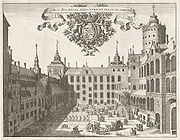
From 1586 Boy focused on the royal church and the decoration of the castle's large square-shaped room. The church was 130 feet in length and located along the northern side of the courtyard. It was topped by a bell tower on which Boy worked in 1589. In 1591 glass and lead were bought for the windows. The king ordered lavish decorations for the square room, including a ceiling in gilded copper for which the gilding alone cost the equivalent of 100 ship pounds (170.000 kg) of copper, which failed to satisfy the king who sent 30 Hungarian gold florins
Ducat
The ducat is a gold coin that was used as a trade coin throughout Europe before World War I. Its weight is 3.4909 grams of .986 gold, which is 0.1107 troy ounce, actual gold weight...
in 1589 to have a large sphere gilded. Boy spent the last years of his life producing sketches for various other projects in the palace, including gilded cornice
Cornice
Cornice molding is generally any horizontal decorative molding that crowns any building or furniture element: the cornice over a door or window, for instance, or the cornice around the edge of a pedestal. A simple cornice may be formed just with a crown molding.The function of the projecting...
s in the dining room, ashlar
Ashlar
Ashlar is prepared stone work of any type of stone. Masonry using such stones laid in parallel courses is known as ashlar masonry, whereas masonry using irregularly shaped stones is known as rubble masonry. Ashlar blocks are rectangular cuboid blocks that are masonry sculpted to have square edges...
s for the so-called "Summer Room" and for the two towers flanking the eastern gate, and he had the spires of the three crown tower raised by 20–30 feet.
Svartsjö
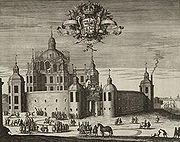
Mälaren
Lake Mälaren is the third-largest lake in Sweden, after Lakes Vänern and Vättern. Its area is 1,140 km² and its greatest depth is 64 m. Mälaren spans 120 kilometers from east to west...
in the 15th century was made royal property by King Gustav I and, under his sons Eric and John, it was transformed into the Svartsjö Palace
Svartsjö Palace
Svartsjö Palace is a palace situated in Svartsjö on the island of Färingsö in lake Mälaren. It is a 30 minute car ride from Stockholm, the capital of Sweden.-History:...
. The responsible architects were those working at the royal palace in Stockholm. The main building was a large cube crowned by a cupola and small towers with a round court surrounded by arcades in two stories in front. While it is difficult to determine which parts Boy was responsible for, he was working on the cupola and the towers in 1579; a correspondence between him and the king mentions the completion of the roof; and in 1586 the royal domains and a chapel near the palace were completed; and two years later the surrounding land was arranged in accordance with Boy's plans. However, when the king paid a visit to the palace in 1591, he was not pleased; construction on the palace in Stockholm had kept Boy busy and the palace at Svartsjö had been neglected and remained uncompleted at the time of the architect's death. The palace was destroyed by fire a century later, a fate shared with most of his works, which seems to confirm Boy was apparently not an architect in the proper sense.
Drottningholm
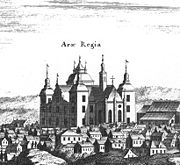
Baroque
The Baroque is a period and the style that used exaggerated motion and clear, easily interpreted detail to produce drama, tension, exuberance, and grandeur in sculpture, painting, literature, dance, and music...
version of the Drottningholm Palace
Drottningholm Palace
The Drottningholm Palace is the private residence of the Swedish royal family. It is located in Drottningholm. It is built on the island Lovön , and is one of Sweden's Royal Palaces. It was originally built in the late 16th century. It served as a residence of the Swedish royal court for most of...
. The royal mansion named Torvesund on the location was rebuilt into a palace by King John III, who was able to take a few rooms in possession in 1580, and the construction seems to have been complete four years later, save for the adornment of the interior.
The centre of this rectangular Renaissance palace was the vaulted palace church, with surrounding rooms connected by open arcades
Arcade (architecture)
An arcade is a succession of arches, each counterthrusting the next, supported by columns or piers or a covered walk enclosed by a line of such arches on one or both sides. In warmer or wet climates, exterior arcades provide shelter for pedestrians....
and loggia
Loggia
Loggia is the name given to an architectural feature, originally of Minoan design. They are often a gallery or corridor at ground level, sometimes higher, on the facade of a building and open to the air on one side, where it is supported by columns or pierced openings in the wall...
s. The choirs of the church possibly had ogive
Ogive
An ogive is the roundly tapered end of a two-dimensional or three-dimensional object.-Applied physical science and engineering:In ballistics or aerodynamics, an ogive is a pointed, curved surface mainly used to form the approximately streamlined nose of a bullet or other projectile.The traditional...
and rose window
Rose window
A Rose window is often used as a generic term applied to a circular window, but is especially used for those found in churches of the Gothic architectural style and being divided into segments by stone mullions and tracery...
s like those at Vadstena Castle
Vadstena Castle
Vadstena Castle is a former Royal Castle in Vadstena, the province of Östergötland, Sweden.-History:Vadstena Castle was originally built by King Gustav Vasa in 1545 as a fortress to protect Stockholm from enemies from the south...
. Characteristic of the palaces built during this era were tower
Tower
A tower is a tall structure, usually taller than it is wide, often by a significant margin. Towers are distinguished from masts by their lack of guy-wires....
s and pinnacle
Pinnacle
A pinnacle is an architectural ornament originally forming the cap or crown of a buttress or small turret, but afterwards used on parapets at the corners of towers and in many other situations. The pinnacle looks like a small spire...
s with adorned hood
Hood
-Apparel:* Hood , type of head covering** Article of Academic dress** Animal hood, something used in costume play or part of an animal transformation fantasy** Bondage hood, sex toy-Anatomy:* Hood , flap of skin behind the head of a cobra...
s, bay window
Bay window
A bay window is a window space projecting outward from the main walls of a building and forming a bay in a room, either square or polygonal in plan. The angles most commonly used on the inside corners of the bay are 90, 135 and 150 degrees. Bay windows are often associated with Victorian architecture...
s, arcades
Arcade (architecture)
An arcade is a succession of arches, each counterthrusting the next, supported by columns or piers or a covered walk enclosed by a line of such arches on one or both sides. In warmer or wet climates, exterior arcades provide shelter for pedestrians....
, and galleries and these were probably also prominent features of the Renaissance palace at Drottningholm.
John named the palace after Queen Catherine Jagellon, which indicates it was never important as a military bastion. While the palace and its chapel were of great importance to the queen, it remained unfinished at the time of her death. An important prototype for the palace was the Wawel Castle
Wawel Castle
The Gothic Wawel Castle in Kraków in Poland was built at the behest of Casimir III the Great and consists of a number of structures situated around the central courtyard. In the 14th century it was rebuilt by Jogaila and Jadwiga of Poland. Their reign saw the addition of the tower called the Hen's...
in Kraków
Kraków
Kraków also Krakow, or Cracow , is the second largest and one of the oldest cities in Poland. Situated on the Vistula River in the Lesser Poland region, the city dates back to the 7th century. Kraków has traditionally been one of the leading centres of Polish academic, cultural, and artistic life...
, and as at Drottningholm, palaces with church gables projecting out of the façades were built throughout Catholic Poland, and a similar scheme was used in Sweden at Borgholm
Borgholm
Borgholm is a city and the seat of Borgholm Municipality, Kalmar County, Sweden with 3,093 inhabitants in 2005. It is located on the island of Öland in the Baltic Sea....
, at the Vadstena Castle
Vadstena Castle
Vadstena Castle is a former Royal Castle in Vadstena, the province of Östergötland, Sweden.-History:Vadstena Castle was originally built by King Gustav Vasa in 1545 as a fortress to protect Stockholm from enemies from the south...
, and at the Uppsala Castle
Uppsala Castle
Uppsala Castle is a 16th century royal castle in the historical city of Uppsala, Sweden. Throughout much of its early history, the castle played a major role in the history of Sweden....
, the enlargement of which was also led by Boy.
Drottningholm became an important centre for Counter-Reformation
Counter-Reformation
The Counter-Reformation was the period of Catholic revival beginning with the Council of Trent and ending at the close of the Thirty Years' War, 1648 as a response to the Protestant Reformation.The Counter-Reformation was a comprehensive effort, composed of four major elements:#Ecclesiastical or...
groups while plague tormented Stockholm in 1579. It eventually burned down in 1661, but even before that the Catholic appearance the palace must have had caused it to be neglected and uncompleted. It was passed back and forth between various nobles and gradually decayed, before an inventory around 1640 described it as a ruin with broken windows.
Churches
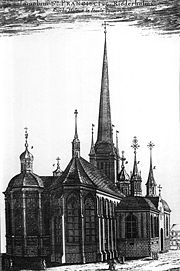
King Eric also ordered two other churches to be constructed in the capital: one dedicated to St Henry and the other to the Holy Trinity
Trinity
The Christian doctrine of the Trinity defines God as three divine persons : the Father, the Son , and the Holy Spirit. The three persons are distinct yet coexist in unity, and are co-equal, co-eternal and consubstantial . Put another way, the three persons of the Trinity are of one being...
. From contemporary accounts it is known the first was bought and used by the Finnish and German parishes
German Church, Stockholm
Tyska kyrkan , sometimes called St. Gertrude's Church , is a church in Gamla stan, the old town in central Stockholm, Sweden....
in 1593. In a letter dated 1584 Boy is said to have led the construction work on St Thomas, and in a letter in 1588 the king orders Boy to decorate the western gable and add a tall spire without replacing the old one. The foundation for the Trinity was laid in 1589 to the plans of Boy but, by the death of the king in 1592, construction work had stopped, with the walls only reaching 6 feet above the ground. St Thomas was rebuilt and enlarged in the 17th century and still exists: Charles IX
Charles IX of Sweden
Charles IX of Sweden also Carl, was King of Sweden from 1604 until his death. He was the youngest son of King Gustav I of Sweden and his second wife, Margaret Leijonhufvud, brother of Eric XIV and John III of Sweden, and uncle of Sigismund III Vasa king of both Sweden and Poland...
handed it over to the German parish who renamed it St Gertrude
German Church, Stockholm
Tyska kyrkan , sometimes called St. Gertrude's Church , is a church in Gamla stan, the old town in central Stockholm, Sweden....
.
Additionally, Boy is believed to be responsible for the design of John III's Renaissance reconstruction of St James's church in Stockholm, built around 1520–1592 and featuring a central nave
Nave
In Romanesque and Gothic Christian abbey, cathedral basilica and church architecture, the nave is the central approach to the high altar, the main body of the church. "Nave" was probably suggested by the keel shape of its vaulting...
flanked by two tall aisle
Aisle
An aisle is, in general, a space for walking with rows of seats on both sides or with rows of seats on one side and a wall on the other...
s resting on sandstone
Sandstone
Sandstone is a sedimentary rock composed mainly of sand-sized minerals or rock grains.Most sandstone is composed of quartz and/or feldspar because these are the most common minerals in the Earth's crust. Like sand, sandstone may be any colour, but the most common colours are tan, brown, yellow,...
columns.
Portraits
The alabaster monument of Princess Isabella (1564–1566), daughter of John III, is in Strängnäs CathedralSträngnäs Cathedral
Strängnäs Cathedral is a cathedral church in Strängnäs, Sweden, since the Protestant Reformation the seat of the Lutheran Diocese of Strängnäs.It is built mainly of bricks in the characteristic Scandinavian Brick Gothic style...
.
Two portraits of Gustav Vasa are assumed to have been made by him: a wooden relief and possibly a watercolour, both found at Gripsholm Castle
Gripsholm Castle
Gripsholm Castle is a castle in Mariefred, Södermanland, in Sweden and is regarded as one of Sweden's finest historical monuments. It is located by lake Mälaren in south central Sweden, in the municipality of Strängnäs, about 60 km west of Stockholm....
.
See also Vasa sarcophagi above.
Payment
His initial salary was 200 dalerSwedish riksdaler
The riksdaler was the name of a Swedish coin first minted in 1604. Between 1777 and 1873, it was the currency of Sweden. The daler, like the dollar, was named after the German Thaler. The similarly named Reichsthaler, rijksdaalder, and rigsdaler were used in Germany and Austria-Hungary, the...
silver coins, a court dress, and emoluments in kind.
On February 28, 1562, Boy travelled to Antwerp, and in 1565 he arrived in Stockholm where King John III
John III of Sweden
-Family:John married his first wife, Catherine Jagellonica of Poland , house of Jagiello, in Vilnius on 4 October 1562. In Sweden, she is known as Katarina Jagellonica. She was the sister of king Sigismund II Augustus of Poland...
appointed him a salary of 1.600 marks
Mark (money)
Mark was a measure of weight mainly for gold and silver, commonly used throughout western Europe and often equivalent to 8 ounces. Considerable variations, however, occurred throughout the Middle Ages Mark (from a merging of three Teutonic/Germanic languages words, Latinized in 9th century...
silver coins annually and emoluments in kind (corn, hops, a court dress, and lodging).
In 1577 he received 200 daler, 144 hectoliters of corn, 1 court dress, 10 pounds of hop, 1 barrel of salt, 1 barrel of butter, 3 oxen, 8 sheep, 6 pigs, 2 barrels of salmon, 1 barrel of cod, 10 pounds of pike, 1 barrel of herring, and fodder for a horse – in total worth 399½ daler.
Work
- Three Crown CastleTre kronor (castle)Tre Kronor or Three Crowns was a castle located in Stockholm, Sweden, on the site where Stockholm Palace is today. It is believed to have been a citadel that Birger Jarl built into a royal castle in the middle of the 13th century...
, StockholmStockholmStockholm is the capital and the largest city of Sweden and constitutes the most populated urban area in Scandinavia. Stockholm is the most populous city in Sweden, with a population of 851,155 in the municipality , 1.37 million in the urban area , and around 2.1 million in the metropolitan area... - Gävle CastleGävle CastleGävle Castle in Gävle, Sweden, is a medieval Castle....
, completed in 1597. - Monument of Gustav VasaGustav I of SwedenGustav I of Sweden, born Gustav Eriksson of the Vasa noble family and later known simply as Gustav Vasa , was King of Sweden from 1523 until his death....
at the Uppsala CathedralUppsala CathedralUppsala Cathedral is a cathedral located centrally in the city of Uppsala, Sweden. It dates back to the late 13th century and at a height of 118.7 m is the tallest church building in Scandinavia. Originally built under Roman Catholicism and used for coronations of the Swedish monarch, since the...
. - Svartsjö PalaceSvartsjö PalaceSvartsjö Palace is a palace situated in Svartsjö on the island of Färingsö in lake Mälaren. It is a 30 minute car ride from Stockholm, the capital of Sweden.-History:...
. - Saint James's church, StockholmStockholmStockholm is the capital and the largest city of Sweden and constitutes the most populated urban area in Scandinavia. Stockholm is the most populous city in Sweden, with a population of 851,155 in the municipality , 1.37 million in the urban area , and around 2.1 million in the metropolitan area...
, 1580-93. - Drottningholm PalaceDrottningholm PalaceThe Drottningholm Palace is the private residence of the Swedish royal family. It is located in Drottningholm. It is built on the island Lovön , and is one of Sweden's Royal Palaces. It was originally built in the late 16th century. It served as a residence of the Swedish royal court for most of...
- Uppsala CastleUppsala CastleUppsala Castle is a 16th century royal castle in the historical city of Uppsala, Sweden. Throughout much of its early history, the castle played a major role in the history of Sweden....

